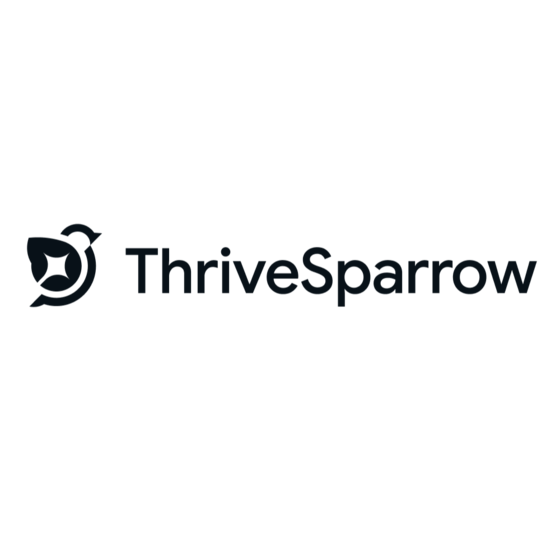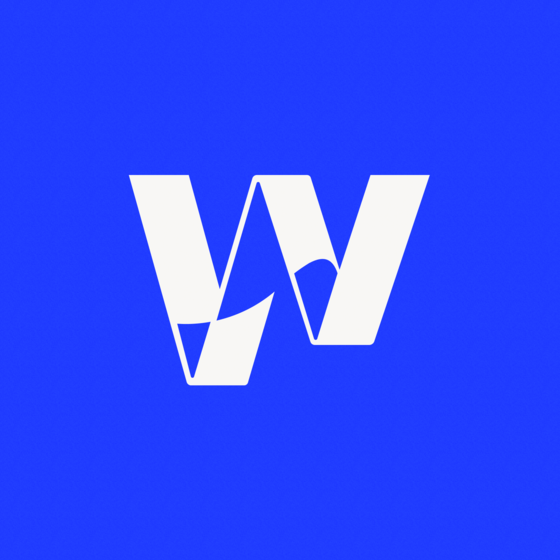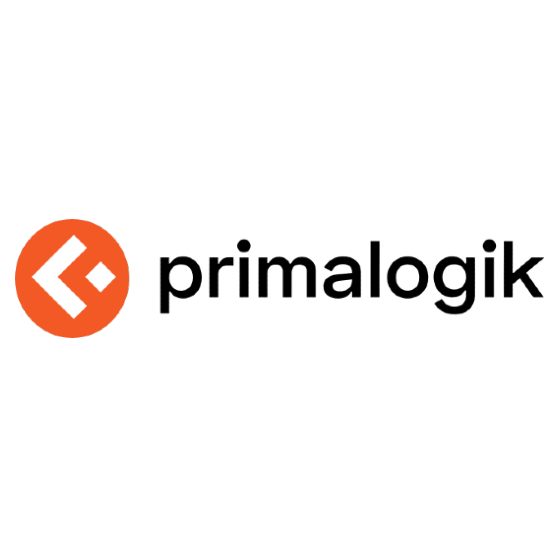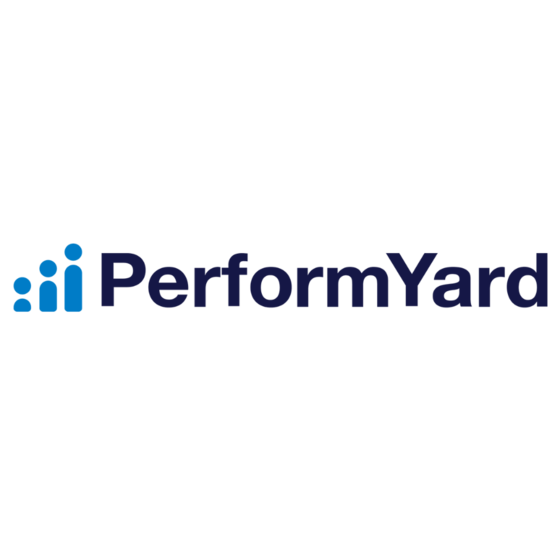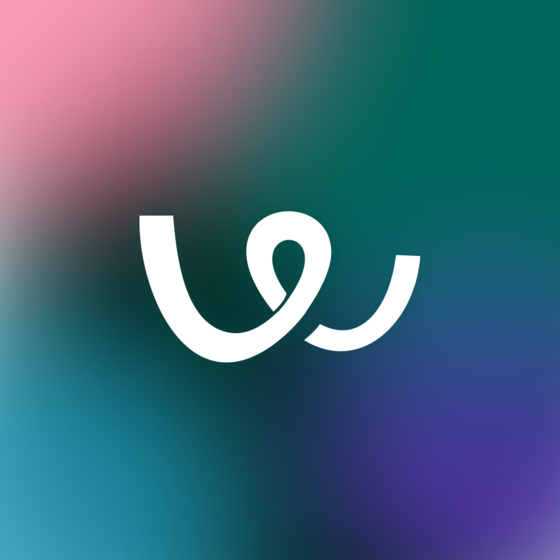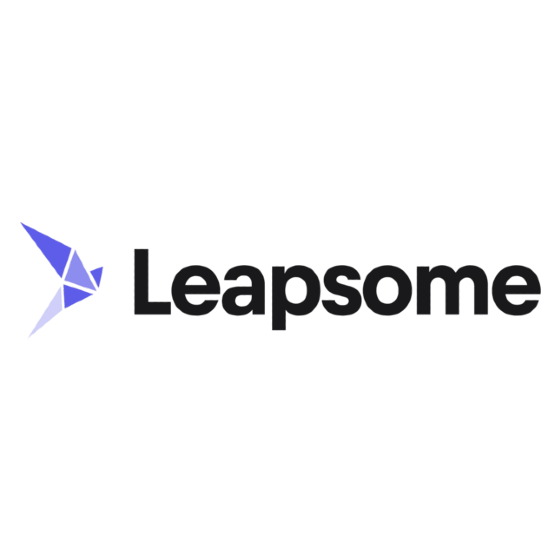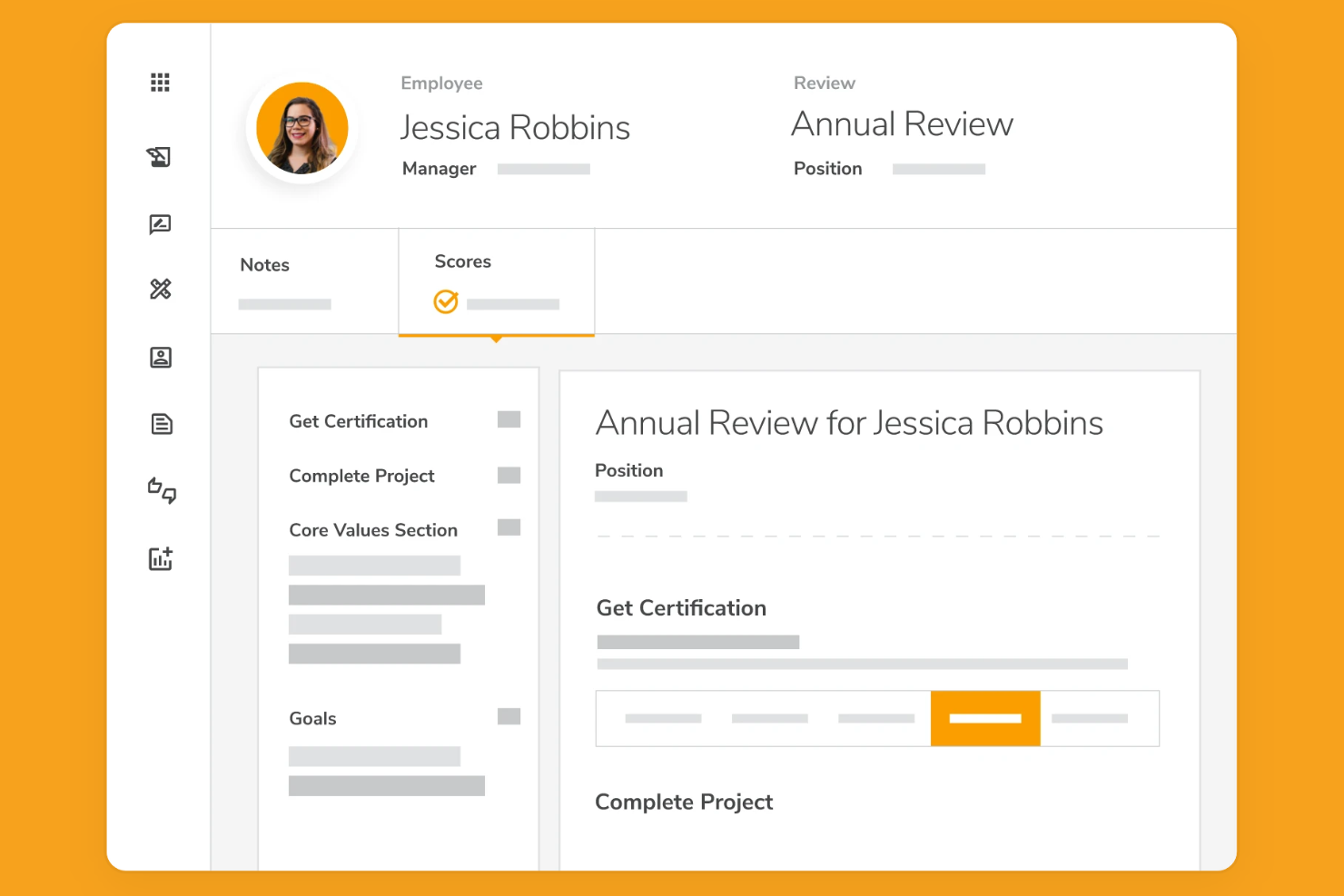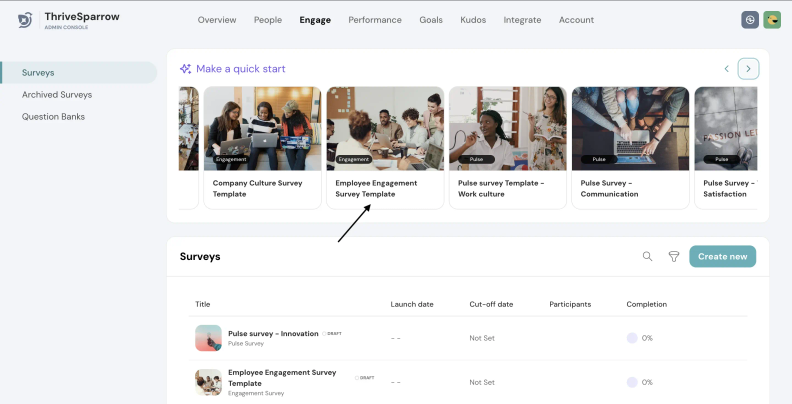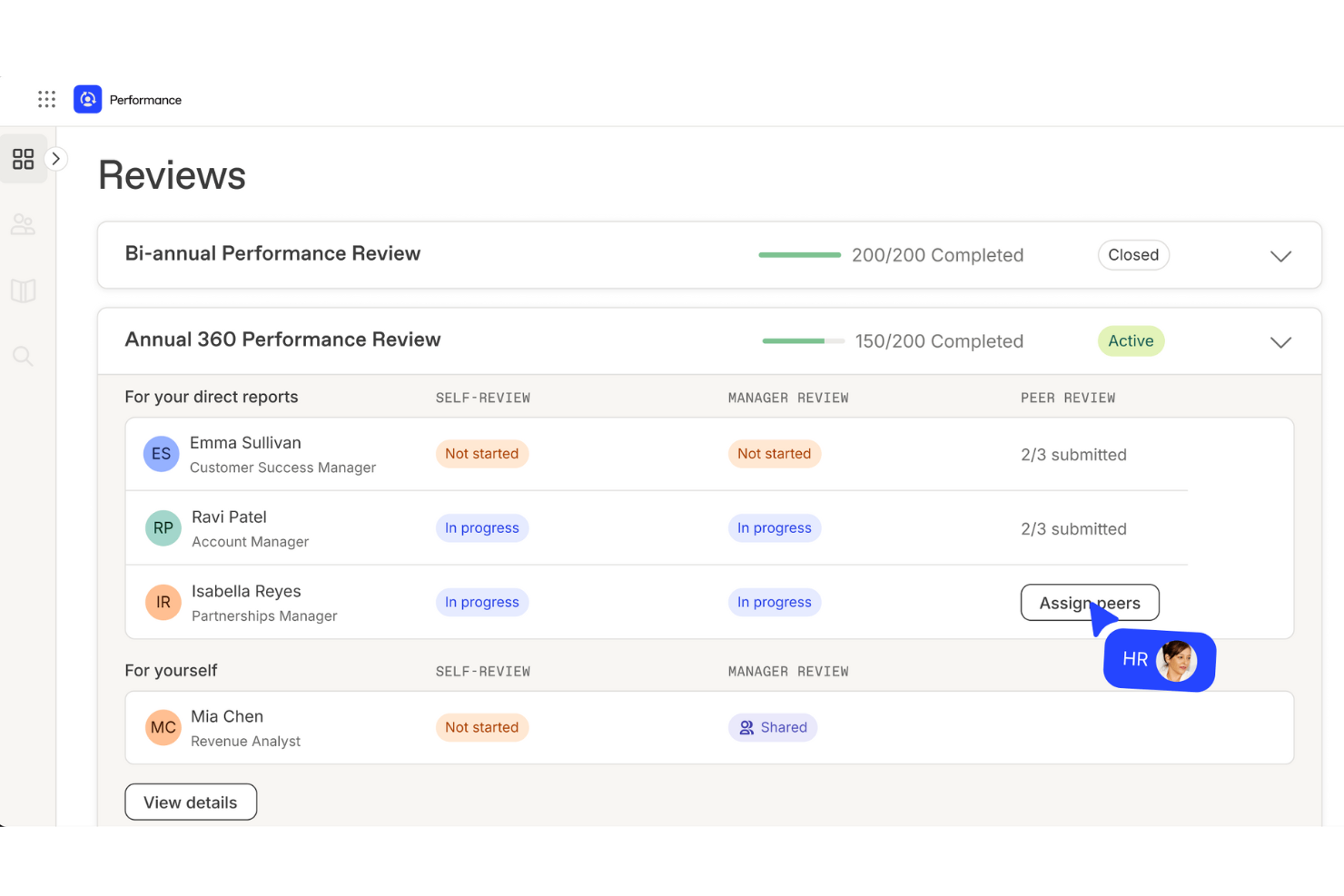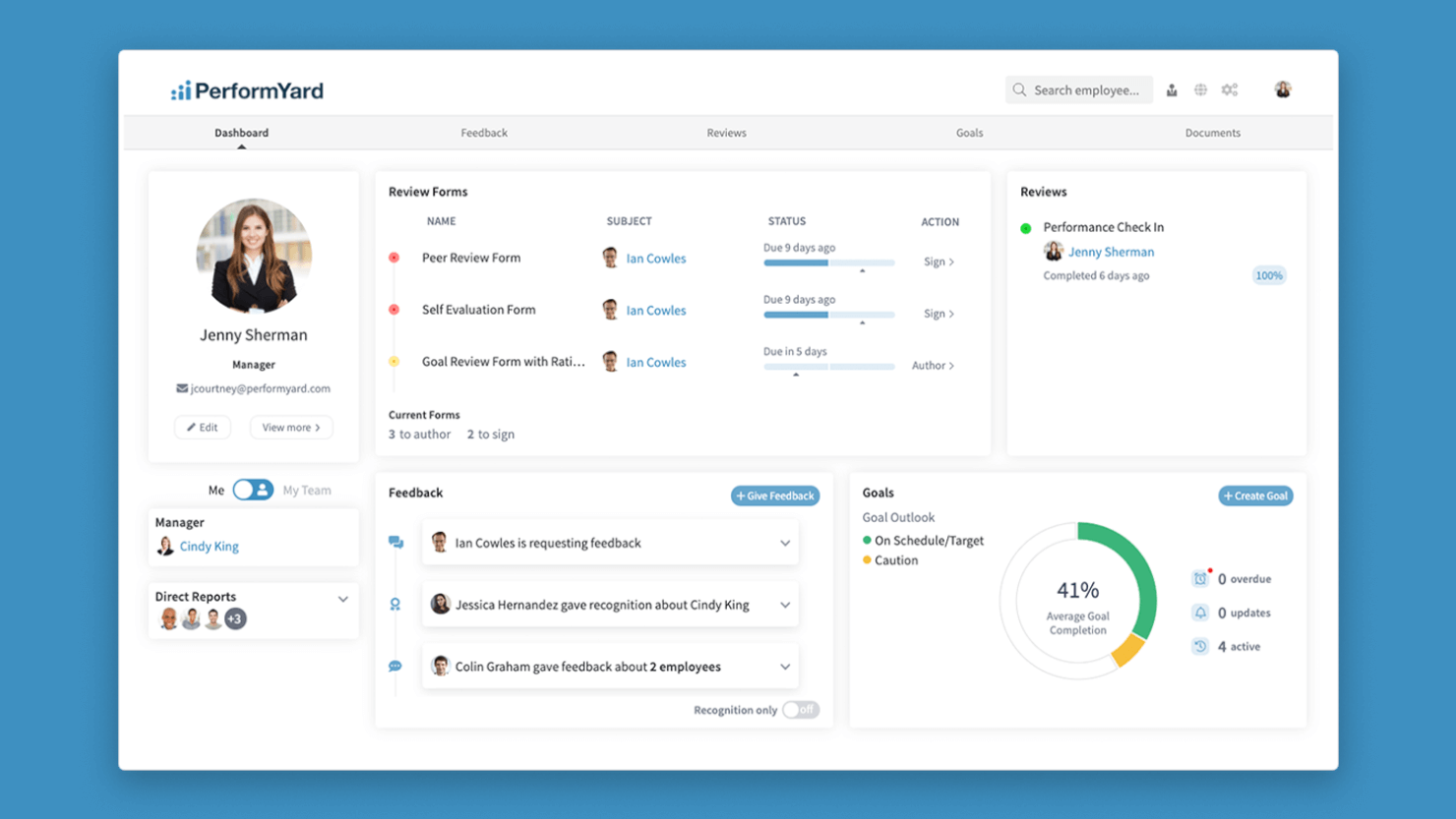10 Best Employee Evaluation Software Shortlist
Here's my pick of the 10 best software from the 20 tools reviewed.
Talk through what you’re looking for. Get a custom shortlist based on your needs. No fees.
If you're searching for the best employee evaluation software to streamline performance reviews, support employee growth, and reduce administrative headaches, you're in the right place.
Many HR professionals I speak to are stuck using clunky tools or spreadsheets that make evaluations inconsistent, time-consuming, and stressful—for both managers and employees. Others are ready to upgrade but feel overwhelmed by too many options that all sound the same. Which one saves time? Which one helps with goal-setting, 360 feedback, or performance tracking?
The right employee evaluation software can help you automate your review cycle, collect and analyze performance data, deliver timely feedback, and drive meaningful employee development, all from a centralized platform.
As a former HR administrator who’s facilitated more than 1,000 performance reviews, I’ve experienced firsthand how the right tools can transform the process. In this guide, I’ll walk you through the top software options available today, so you can confidently choose a solution that works for your team.
Why Trust Our Software Reviews
We've been testing and reviewing HR software since 2019. As HR professionals ourselves, we know how critical and difficult it is to make the right decision when selecting software.
We invest in deep research to help our audience make better software purchasing decisions. We've tested more than 2,000 tools for different HR use cases and written over 1,000 comprehensive software reviews. Learn how we stay transparent, and take a look at our software review methodology.
Best Employee Evaluation Software: Comparison Chart
This comparison chart summarizes pricing, trial, and demo details for my top employee evaluation software selections to help you find the best software for your budget and business needs.
| Tool | Best For | Trial Info | Price | ||
|---|---|---|---|---|---|
| 1 | Best for evaluating goals and competencies | Free demo available | From $2 to $7/employee/month | Website | |
| 2 | Best for continuous one-on-one feedback | Free trial + demo available | From $29/month | Website | |
| 3 | Best for goal progression assessments | Free demo available | Pricing upon request | Website | |
| 4 | Best for consistent 360-degree feedback | Free demo available | From $11/seat/month | Website | |
| 5 | Best for evaluation analytics tools | 14-day free trial | From $2/employee/month | Website | |
| 6 | Best for flexible performance reviews | Free trial available | From $5/user/month | Website | |
| 7 | Best for intuitive employee reviews | 30-day free trial | From $3 to $8/user/month | Website | |
| 8 | Best for streamlined performance management | Free demo available | From $5 to $10/user/month | Website | |
| 9 | Best for customizable review cycles | Free trial available | From $299/month | Website | |
| 10 | Best for performance, engagement, and learning | 14-day free trial | From $8/user/month | Website |
-

Rippling
Visit WebsiteThis is an aggregated rating for this tool including ratings from Crozdesk users and ratings from other sites.4.8 -

Guru
Visit WebsiteThis is an aggregated rating for this tool including ratings from Crozdesk users and ratings from other sites.4.6 -

Absorb LMS
Visit WebsiteThis is an aggregated rating for this tool including ratings from Crozdesk users and ratings from other sites.4.6
Best Employee Evaluation Software Reviews
The right employee evaluation software can streamline performance reviews, enhance feedback, and support growth. I’ve reviewed my top 10 picks, highlighting key features, pros and cons, integrations, and ideal use cases—so you can quickly find the best fit for your team.
Performance Pro is a cloud-based solution designed to help organizations manage performance evaluations and improve employee development. It's tailored for small to mid-sized organizations and it helps managers and employees set goals and monitor individual competencies as part of the performance appraisal process.
Why I picked Performance Pro: I included Performance Pro in this list because it helps managers evaluate individual employee goals and competencies, making it ideal for fostering growth and aligning individual contributions with organizational objectives.
It's best suited for mid-sized company HR management as it is specifically designed and priced with small to mid-sized companies in mind, offering practical tools for performance management and compensation management, while also focusing on continuous improvement to support workforce success.
Performance Pro Standout Features and Integrations:
Features include customizable evaluation forms, automated reminders for reviews, and detailed reporting tools to track development progress. These tools help your team stay organized and focused on meaningful performance metrics.
I also appreciate the link between goals, performance, and merit-based salary increases which helps motivate employees to reach and exceed their goals.
The platform also offers 360-degree feedback collection, a comprehensive library of competencies and job descriptions, numerous goal-setting tools.
An integration is available with Compease to help with merit-based compensation increases and planning. Integrations are also available with HCM or payroll software, though specific platforms are not named.
Deel is an all-in-one HR platform designed to simplify the management of international teams. It's core HR platform helps businesses hire, onboard, and pay employees and contractors globally, ensuring compliance with local labor laws, handling payroll in multiple currencies, and managing performance.
Deel also offers a separate product — Deel Engage — which offers talent and performance management features.
Why I picked Deel: Deel Engage offers three core talent management functions rolled into one platform, including: performance management software, career development software, an a learning management system.
As an employee evaluation tool, Deel’s Engage suite helps facilitate seamless one-on-one meetings, which are crucial for continuous employee evaluation, development, and feedback. You can schedule and manage these meetings efficiently, ensuring regular check-ins and meaningful interactions between team members.
The software also uses AI to help managers identify high-potential talent and build competency-based career progressions frameworks, positively impacting both employee engagement and retention.
Deel Standout Features and Integrations:
Key features include performance reviews, growth plans, OKRs, and goals. Furthermore, the platform offers 360-degree feedback reviews and evaluations that are fully customizable. You can also access comprehensive analytics to gain insights into employee goals, progress, and potential development opportunities.
It also has robust integration with widely used communication tools like Slack, enabling seamless collaboration and connectivity regardless of geographic location.
Deel also offers various Slack plug-ins like referrals, kudos, PTO, org charts, and more, to help manage time off requests, engage employees, and automate reminders for upcoming reviews and evaluations.
Integrations include BambooHR, Expensify, Greenhouse, Ashby, HiBob, Xero, Workday, Netsuite, Okta, OneLogin, QuickBooks, SCIM, Slack, and Workable. An Open API is available for custom integrations.
New Product Updates from Deel
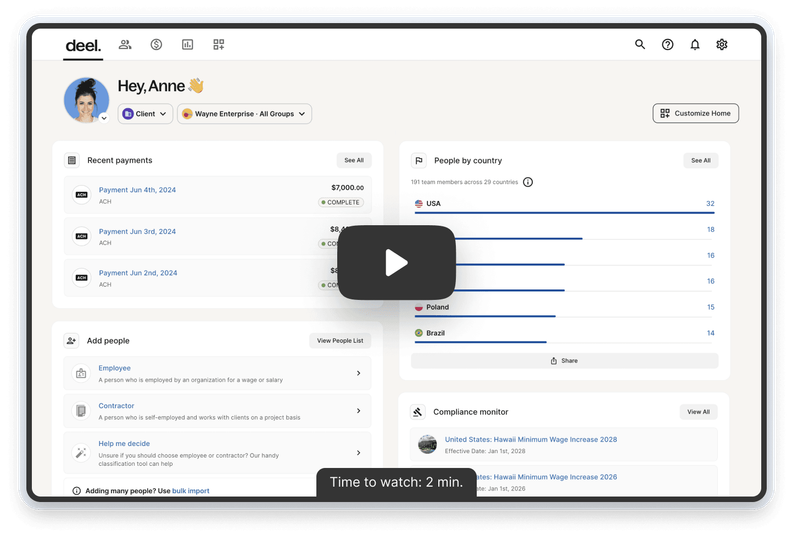
500+ New Platform Enhancements for Global Hiring and Payroll
Deel announced over 500 platform enhancements focusing on global hiring, HR, payroll, and AI-driven compliance, featuring tools for faster hiring, smarter HR management, strategic planning, and enhanced payroll flexibility. For more details, visit the source: Deel Blog.
Mitratech Trakstar is a flexible performance management system that helps you keep your employees on track with goals and continuous feedback. Its Perform product offers evaluation templates, automated workflows, and configurable forms to help you get your performance management program up and running fast.
Why I picked Mitratech Trakstar: Within its Perform product, the data analytics help managers analyze performance trends over time and identify areas for improvement.
Managers can examine an employee's progress in various areas, including skills development, project management, and overall task completion, and compare that progress against those in the same role or department.
You can also use Mitratech Trakstar to set SMART goals for your employees and your team as a whole, and track progress over time. The goal section has a timeline, so each individual gets a visual representation of how their progress is going.
Sending and receiving reviews is also easy. You can tie certain goals to reviews, add and share goal-related notes, and set up notifications to complete evaluations. Team managers receive reports on how their team is doing, and they can set up their dashboard to track department and team member goals at a glance.
Mitratech Trakstar Standout Features and Integrations:
Features within the Perform product include comprehensive employee reviews, 360-degree reviews, SMART goals and goal alignment tools, continuous feedback check-in tools, and performance benchmarks. The system also houses employee job descriptions, making it straightforward to compare employee performance against formal expectations.
The feedback collection process is also easy with Mitratech Trakstar. The software gives managers multiple survey options, so they can weigh different aspects of their team’s performance.
It also includes the ability to collect multi-rater feedback from a group of close colleagues (also called 360-degree feedback), as well as an employee self-assessment feature that allows employees to evaluate their own performance before they meet with their manager.
Integrations are available with Google Workspace, Okta, and OneLogin.
Lattice is a people management platform that helps you set up goals, run surveys, track employee performance, and reward high-performing individuals.
Their talent management platform includes core modules for performance and goals & OKRs, with optional add-ons for employee engagement, employee development, and compensation review tools.
In addition, for US-based businesses only, Lattice also offers a new HRIS product, including optional add-ons for payroll and time-tracking.
Why I picked Lattice: One of the best things about their evaluation software is that it's easy to schedule and distribute surveys and performance reviews.
The automatic prompting feature makes it very easy to collect 360-degree feedback, or you can set it up to ask about your team’s mood, concerns, achievements, and other criteria that are relevant to your business.
You can gauge employee morale using a variety of survey formats, including pulse surveys, eNPS surveys, and onboarding or exit surveys. Once your data is in, the platform uses AI to make analyzing your survey for sentiment analysis and other actionable insights easier.
Lattice also offers an extensive question library and the option to include custom questions in your surveys.
Lattice Standout Features and Integrations:
Features include traditional performance reviews, 360-degree employee reviews, objectives and key results (OKR) reviews, and tools to schedule and run pulse surveys and one-on-one interviews.
The platform’s 1:1s are easy to manage by both team leaders and employees, and you can connect your other surveys and reviews to the 1:1 meeting agenda so they can serve as talking points or reminders.
Managers can also compare multiple reviews to assess performance from multiple angles, and quickly track progress at a glance to see how personal goals align with those of the company.
Lattice also includes tools for praising high-performing individuals in public or private and helps managers discover growth opportunities for their team members.
Integrations are available natively with hundreds of solutions, including BambooHR, Jira, Microsoft Teams, Okta, Slack, Zenefits, and many others.
ThriveSparrow is an AI-powered employee success platform designed to enhance workplace performance and engagement through automated peer recognition and rewards.
Why I picked ThriveSparrow: It offers four core modules to manage different aspects of the employee experience: performance management, goals & OKRs, employee engage, and employee rewards and recognition.
Its 360-degree performance review system (part of the Performance product) collects feedback from peers, managers, and the employees themselves. This holistic approach ensures that evaluations are well-rounded, providing a complete picture of an employee's performance.
Using their Vault feature (essentially a rewards marketplace), you can also use ThriveSparrow to create customizable recognition programs that mesh with your unique culture and values, while relying on automations for numerous admin aspects.
ThriveSparrow Standout Features and Integrations:
Key features include personal development plans, team-based performance analytics, performance trend analysis tools, employee survey tools (including multilingual surveys and eNPS surveys), comprehensive feedback reviews including heatmap analysis, and AI-driven insights.
ThriveSparrow also offers robust analytics tools that provide valuable insights into employee engagement and performance trends, helping HR professionals make better data-driven decisions. The system also offers action plans, which are essentially targeted growth plans based on performance feedback.
Integrations include BambooHR, HiBob, HR Partner, Sage HR, Gusto, Personio, 7shifts, Dayforce, Justworks, OneLogin, JumpCloud, Oyster, UKG Ready, Officient, and Humaans.
New Product Updates from ThriveSparrow
New Survey-Builder
ThriveSparrow's updated survey-builder allows HR teams to create and distribute engagement surveys quickly, with guided question selection, branding, and distribution options. More details at ThriveSparrow Blog.
Workleap Performance is an employee evaluation software designed to simplify performance management for HR professionals, managers, and employees. It offers customizable review processes, helping organizations tailor performance evaluations to their specific goals and company culture.
Why I picked Workleap Performance: It stands out for its flexible review cycle builder, enabling you to create and manage performance review cycles at your own pace. Its customizable evaluation criteria let you focus reviews on the areas most relevant to your business needs. The platform supports self, peer, and manager reviews, providing a 360-degree view of employee performance.
Additionally, configurable audiences within review cycles ensure the right questions reach the right people. This holistic approach encourages clear expectations, relevant assessments, and continuous improvement by incorporating feedback from multiple perspectives.
Workleap Performance Standout Features and Integrations:
Key features include automated performance review notifications that help streamline the review cycle by reducing delays and improving communication. The platform also provides a review cycle list, giving you an overview of participant progress across all review cycles at any time.
In addition, the review forms are designed to develop a simple structure with the right questions tailored to your company’s culture and goals, facilitating meaningful feedback.
Integrations include Microsoft Teams, Slack, BambooHR, ADP Workforce Now, Factorial, Gusto, HiBob, Paycor, Paylocity, Personio, Sage HR, Workday, and many others.
Primalogik is an employee evaluation software that's known for product simplicity and customer-centricity. Its employee performance management software includes a wide range of features that foster employee engagement and empower managers and their employees to reach their full potential.
Why I picked Primalogik: It's easy to collect employee feedback from multiple sources, including 360-degree feedback. Admin users can select their own rating scales for their evaluation questionnaires, and determine the level of anonymity that will be applied to the feedback.
Once employee feedback is in the system, Primalogik has several tools to support deep analysis of the data. For example, their intuitive system allows managers to compare employees’ self-ratings side-by-side against other respondents’ feedback. This helps identify any blind spots between where an employee believes they are and what their co-workers have suggested.
Primalogik's comparison mode allows admin users to benchmark each employee appraisal and compare them across their workforce— a useful way of identifying their overall top performers or spotting potential company-wide skill gaps.
Primalogik Standout Features and Integrations:
Features include performance review assessments, 360-degree feedback, engagement surveys, employee goals and OKRs, and instant feedback tools like 1:1 check-ins. These features work together to help managers and employees gain insight into their individual performance and uncover areas to make improvements.
Advanced features in this module include the option for managers and admin staff to launch feedback requests about their employees and solicit responses from specific co-workers; automatic reminders to provide feedback by a certain date; and real-time feedback tracking.
Their performance management software is also available in Spanish or French.
Integrations are available with ADP, BambooHR, Google Workspace, Microsoft Azure, and Okta.
PerformYard's employee evaluation software provides flexible features for HR, while creating a simplified employee performance review experience for your staff.
Why I picked PerformYard: With PerformYard, your HR team will get the tools they need to build out any employee evaluation strategy, and employees get a streamlined experience so they can focus on quality feedback and effective performance discussions. It doesn't try to insert itself at every opportunity or replace important conversations.
In addition to your annual performance review cycle, PerformYard can also help you run regular check-in meetings, capture continuous feedback, recognize staff achievements, and document employee goals.
PerformYard Standout Features and Integrations:
Features include continuous feedback tools, manager feedback, feedback requests for direct reports, and flexible employee evaluation formats.
You can customize their performance review software to fit the strategy that's right for your organization, including 360-degree reviews, project-based reviews, rating scales, continuous feedback, and cascading goals.
Other notable features include 9-box performance grids, performance trend analysis tools, and numerous performance visualization tools that help users digest information easier.
Another highlight is the fact that PerformYard provides dedicated customer success managers for every customer, to help you design an effective performance management cycle tailored to your own unique business needs.
From onboarding, to employee training, to ongoing support, you'll have someone at your side to help you troubleshoot any issues.
Integrations are available with most major HRIS and payroll systems including ADP, BambooHR, Gusto, Rippling, UKG, Paycom, Workday, and Paylocity.
Workable HR is an all-in-one human resources software platform designed to optimize a variety of HR functions, including hiring, employee data management, time tracking, and payroll.
Why I picked Workable HR: Its customizable review cycles let you set up performance reviews that reflect your company goals and development objectives. This means you’re not locked into a one-size-fits-all process.
Instead, you can adapt the evaluation process to match specific roles, departments, or career stages, making sure that each review has real value for both employees and managers. This flexibility helps ensure that evaluations actually support growth, rather than just being an HR checkbox.
Furthermore, the platform offers a multi-level feedback system, which helps create a more rounded evaluation. Your team members can conduct self-reviews, while managers and peers can add their insights for a full 360-degree perspective.
Workable HR Standout Features and Integrations:
Other features include default review templates that can be customized, saved, and reused, which takes out the stress of creating new forms from scratch each review cycle. You can even set deadlines for reviews, so everyone stays on track.
Beyond performance, Workable also offers candidate sourcing tools, so you can access a wide talent pool, making it easier to bring in quality hires from the start. It also has a self-service portal and a robust employee data management system.
Integrations include Indeed, BambooHR, HiBob, Checkr, Certn, ADP, Deel, LinkedIn, G-Suite, Microsoft 365, Spark Hire, and Slack.
Leapsome is the all-in-one employee evaluation platform that helps organizations enhance their management processes. Used by companies like Spotify, Workato, and monday.com, Leapsome enables a continuous cycle of performance management and personalized learning that powers the growth of your people and business.
Why I picked Leapsome: Leapsome offers a full set of employee evaluation tools, including employee engagement surveys that identify drivers and measure your employees’ satisfaction over time.
Whether through custom questions or Leapsome’s expert templates, the tool helps you turn company sentiment into action items. Key highlights of this feature include customizable frequency and questions, the ability to segment surveys by department, performance, and more, and automated survey analytics.
Leapsome Standout Features and Integrations:
Features include performance review cycles are fully customizable and easy to set up. You can scheduled employee reviews to automatically recur at predetermined timelines, such as quarterly, semi-annually, annually, or even use them to wrap up probationary periods.
Other key features include 360-degree feedback (including anonymous feedback), expert question templates, skill frameworks, development paths, automations, and powerful analytics.
Leapsome also includes an OKR module to help manage goals and objectives at the company, team, and individual levels, as well as helpful visuals like goal trees that help you connect the big picture to the tiny details.
Lastly, for any employees needing upskilling, Leapsome includes the tools teams need to create customized learning paths for training and employee development, built around specific teams, skill sets, or topics.
Integrations are available with Active Directory, ADP, BambooHR, GSuite, HiBob, Jira, Microsoft Teams, PayFit, Personio, Rippling, Slack, and others.
Other Employee Evaluation Software
Here are a few more options that didn’t make into the best employee evaluation software shortlist, but are still worth taking a look at:
- Trinet
For combined software and services
- Kudos
Points-for-gifts recognition system
- Culture Amp
For honest, anonymous surveys
- Xoxoday Compass
For gamified incentive programs
- eloomi
For ease of use
- Sage HR
For quick feedback
- Cornerstone OnDemand
For visual reports
- Small Improvements
For 1:1 mentoring
- Synergita
Results-focused OKRs
- AssessTEAM
For detailed performance reports
Related HR Software Reviews
If you still haven't found what you're looking for here, check out these other related tools that we've tested and evaluated:
- HR Software
- Payroll Software
- Recruiting Software
- Employer of Record Services
- Applicant Tracking Systems
- Workforce Management Software
Selection Criteria for Employee Evaluation Software
To make this list, each tool had to go beyond the basics—solving real HR pain points and making performance reviews easier, faster, and more effective. My picks are based on hands-on testing and in-depth research to see which platforms actually deliver on their promises.
Here’s a summary of the selection criteria I used:
Core Functionalities (25% of total score): To be considered for inclusion in this list, each solution had to fulfill these common use cases first:
- Customizable evaluation forms that can be tailored to specific job roles and objectives.
- Goal setting and tracking tools to align employee objectives with organizational goals.
- 360-degree feedback tools to create a comprehensive, well-rounded view of employee performance from multiple sources.
- Comprehensive analytics and reporting that enables data-driven decisions regarding employee performance.
Additional Standout Features (25% of total score): To help me find the best software out of numerous available options, I also kept a keen eye out for unique features, including the following:
- Mobile accessibility, which enables evaluations and feedback on the go, highlighting flexibility in use.
- Real-time performance-related feedback mechanisms or continuous feedback tools.
- Integrations with other HR systems that will reduce manual data input and streamline workflows.
- Software that goes beyond generic capabilities, such as advanced analytics tools for predicting performance trends or identifying training needs.
Usability (10% of total score): To evaluate the usability of each system, I considered the following:
- A balance between powerful functionality and ease of use, ensuring a software that can be easily navigated without extensive training.
- Aesthetic interface design that facilitates a positive user experience, with clear, intuitive navigation and layout.
Onboarding (10% of total score): To get a sense of each software provider's customer onboarding process, I considered the following factors:
- Quick and easy onboarding processes, including the availability of training videos, customizable templates, and interactive product tours.
- Evaluation of the extent to which a new user can quickly migrate to the tool and start realizing value, supported by resources like chatbots and webinars.
Customer Support (10% of total score): To evaluate the level of customer support each vendor offered, I considered the following:
- Responsive and knowledgeable customer support, assessed through response times and the availability of multiple support channels.
- Quality of resources provided for troubleshooting and learning about the software.
Value for Price (10% of total score): To gauge the value of each software, I considered the following factors:
- Comprehensive evaluation of pricing structures against the competition, considering the range of features offered for the price.
- Assessment of different plans available, ensuring there's a suitable option for businesses of varying sizes and needs.
Customer Reviews (10% of total score): Evaluating customer reviews is the final element of my selection process, which helps me understand how well a product performs in the hands of real users. Here are the factors I considered:
- Analysis of feedback from current and former users regarding their experiences with the software, focusing on reliability, user satisfaction, and the impact on performance evaluation processes.
- Seeking out patterns in reviews that indicate strengths or weaknesses in areas like usability, customer support, and overall value.
Using this assessment framework helped me identify the software that goes beyond basic requirements to offer additional value through unique features, intuitive usability, smooth onboarding, effective support, and overall value for price.
How to Choose Employee Evaluation Software
When selecting employee evaluation software, the right choice depends on your team's unique needs. Here are a few key considerations to guide your decision:
- What problems are you trying to solve?
Start by identifying the core challenges you're facing with employee evaluations. Are reviews inconsistent or time-consuming? Are feedback cycles unclear or untracked? Clarifying these pain points will help you zero in on features that offer the most impact—like automation, real-time feedback, or customizable templates. - Who will use the software?
Think about who needs access—and how they'll use the tool. Once you map out your users, rank their needs. What do managers need most? What features will help employees engage with the process? Prioritizing your user groups will ensure the tool works well across the board. - What is your budget?
To estimate costs, evaluate your current headcount and growth projections. Since most platforms charge per user per month, understanding your team size over time helps you anticipate long-term costs—and avoid surprises later. - What software integrations do you need?
Will this tool replace another, or work alongside your existing systems? Look for integrations with your HRIS, LMS, or communication tools like Slack or Microsoft Teams. Seamless connections save time and keep your workflows running smoothly. - What outcomes are important and how will you measure success?
It’s easy to get caught up comparing feature lists. But before diving into demos, define what success looks like. Do you want to streamline reviews? Improve employee engagement? Enable better data-driven decisions? Having a clear vision of your desired outcomes upfront will keep your selection process focused and productive. - Does it align with your tech stack and workflows?
Check compatibility with the systems you already use—like Google Workspace or Microsoft 365. Also consider whether the platform offers mobile performance review apps or self-service portals to keep the user experience simple for employees and managers alike.
At the end of the day, the best employee evaluation software is the one that fits your people, your processes, and your goals. Don’t be swayed by popularity—go with what works best for your organization.
AI is starting to make a big impact in HR, especially in things like talent acquisition and performance reviews, but you need to be careful about how much you rely on it.
Trends in Employee Evaluation Software for 2025
In recent years, the way businesses measure performance and conduct employee evaluations has changed significantly. With the emphasis shifting toward growth-centered, frequent, and holistic assessments, employee evaluation software has been evolving to keep pace.
Here are several key trends that are shaping employee evaluation tools currently:
- More Frequent and Flexible Performance Discussions: As businesses move away from annual reviews to continuous performance management, employee evaluation software increasingly supports frequent check-ins, 1-on-1 meeting management, and structured feedback cycles to provide timely, impactful feedback that drives rapid skill development and alignment with company goals.
- 360-Degree Feedback for Holistic Assessments: With the rise of 360-degree feedback, tools now offer expanded capabilities for gathering insights from various sources, including peers and clients, and templates for evaluating soft skills. This trend supports a more inclusive view of performance that values collaboration and reduces competitive behaviors.
- AI-Driven Predictive Analytics: AI-powered features in employee evaluation software now offer predictive insights that help managers proactively identify growth opportunities and anticipate performance trends.
- Strengths-Based Development: Moving beyond traditional performance management models, many organizations are adopting strengths-based evaluations that highlight employee skills and contributions. New software features, like skills mapping and recognition tools, help reinforce a positive feedback culture, shown to increase engagement and productivity.
- Integrated Learning Management Systems (LMS): To create a continuous growth ecosystem, more platforms now offer LMS integrations that connect evaluations with training resources, enabling seamless transitions between performance feedback and skill development.
- Gamification for Engagement and Skill Development: New gamification features, such as badges, leaderboards, and rewards, make skill-building more engaging and enjoyable, driving a culture of continuous improvement and motivation within the workplace.
- Decline of Traditional Annual Appraisals: As continuous feedback becomes the norm, annual appraisals are becoming less relevant, with many software platforms focusing on flexible performance tracking systems that better support real-time development needs in fast-paced business environments.
These trends reflect a shift towards agile, growth-oriented, and data-driven employee evaluation practices that are increasingly essential for today’s organizations.
Integrating these trends into your employee evaluation process—and tapping into the new feature suites that facilitate them—helps you not just conduct evaluations more effectively, but also provide more impactful feedback, drive engagement, and improve retention.
Some parts of the performance review that are data-driven can be assessed by AI, but interpersonal and soft skills require a human touch. Performance management is more than just the review itself—it’s about ongoing one-on-ones, managing relationships, and motivating employees.
What is Employee Evaluation Software?
Employee evaluation software is a digital tool that helps HR teams assess, track, and improve employee performance through structured reviews and feedback.
It’s used by HR professionals and team leads to streamline performance appraisals, automate feedback collection, and align individual goals with company objectives—eliminating manual processes and reducing missed reviews.
Performance management creates a roadmap and helps align employee goals with organizational objectives. It’s a motivator and critical for career progression.
Features of Employee Evaluation Software
When I'm researching different employee evaluation software options, I keep an eye out for the following features to get a sense of what each platform offers:
- Customizable Evaluation Forms: This feature allows organizations to tailor evaluation forms to fit specific job roles, objectives, and competencies. It ensures that the evaluations are relevant and aligned with the company’s goals, making the assessment process more effective.
- Goal Setting and Tracking: Setting clear, measurable goals and tracking progress towards achieving them is essential for both employee development and business success. This feature helps in aligning individual objectives with company goals, providing a clear roadmap for employees.
- 360-Degree Feedback: It enables gathering feedback from multiple sources, including peers, subordinates, and supervisors, offering a comprehensive view of an employee's performance. This holistic approach promotes a more balanced and fair evaluation.
- Self-Assessment Capabilities: Allowing employees to assess their own performance encourages self-reflection and personal accountability. It also provides valuable insights to managers on how employees perceive their own strengths and weaknesses.
- Real-Time Feedback: This feature supports continuous performance management by enabling managers and peers to provide immediate feedback on an employee's work. It helps in addressing issues promptly and recognizing achievements in a timely manner.
- Analytics and Reporting Tools: Powerful analytics enable organizations to identify trends, strengths, and areas for improvement across teams or the entire organization. These insights are crucial for making data-driven decisions related to workforce management.
- Integration with HR Systems: Integration with other HR systems (such as payroll, learning management systems, and attendance tracking) ensures a seamless flow of information and reduces the need for manual data entry, enhancing efficiency and accuracy.
- User-Friendly Interface: An intuitive and easy-to-navigate interface ensures that both employees and managers can use the software effectively without extensive training, increasing adoption rates and ensuring consistent use.
- Mobile Accessibility: With remote work becoming more common, having mobile access to evaluation software allows employees and managers to complete evaluations, check goals, and provide feedback from anywhere, at any time.
- Security and Data Privacy: Protecting sensitive employee performance data is paramount. The software must adhere to high security and privacy standards to ensure that data is stored and transmitted securely.
Choosing employee evaluation software with the right combination of features will significantly enhance the effectiveness of your performance review process. By narrowing down the features that are most crucial for your use case, you can be sure to find software that best meets your needs.
Benefits of Employee Evaluation Software
Employee evaluation software offers a structured approach to assessing, tracking, and enhancing employee performance over time.
By automating and streamlining the evaluation process, organizations can focus more on strategic development and less on administrative tasks. Below are five primary benefits of leveraging employee evaluation software for users and organizations.
- Enhanced Performance Tracking: This software provides a systematic way to monitor and record employee performance continuously. It benefits the business by offering real-time insights into workforce productivity, enabling timely interventions and adjustments to meet organizational goals.
- Streamlined Evaluation Process: Automating the evaluation process reduces the administrative burden on HR and management teams. This efficiency allows for more frequent and consistent performance assessments, leading to a clearer understanding of employee capabilities and areas for improvement.
- Objective Feedback and Analysis: Employee evaluation software facilitates unbiased performance reviews by relying on data and established metrics. This objectivity helps in making fair and informed decisions regarding promotions, compensations, and development opportunities, ultimately benefiting the organization's culture and employee morale.
- Goal Alignment and Tracking: The software ensures individual employee goals are aligned with the organization's objectives. This alignment clarifies expectations for employees, driving engagement and productivity by providing a clear sense of direction and purpose.
- Personalized Development Plans: By identifying strengths and areas for improvement, the software enables the creation of tailored development plans for each employee. This personalized approach supports employee growth and retention, contributing to a skilled and motivated workforce.
Employee evaluation software represents a transformative investment for businesses keen on nurturing a high-performance culture. For organizations looking to thrive in competitive markets, adopting such a system could very well be the stepping stone to achieving outstanding workforce productivity and satisfaction.
Costs & Pricing for Employee Evaluation Software
These software solutions come in various plans and pricing to fit the diverse needs and budgets of different organizations. Understanding what each plan offers is key to selecting the right one for your business's specific requirements.
Plan Comparison Table for Employee Evaluation Software
Below is a table that outlines the pricing and plan structures for employee evaluation software, designed to help you compare your options at a glance.
| Plan Type | Average Price | Common Features |
|---|---|---|
| Free | $0 | Basic performance tracking, access for a limited number of users, and basic evaluations |
| Basic | $5-10 per user/month | Enhanced performance tracking, customizable evaluations, real-time feedback, and basic analytics |
| Professional | $10-20 per user/month | All Basic features plus goal setting and tracking, 360-degree feedback, advanced analytics, and basic software integrations |
| Enterprise | Custom pricing | All Professional features plus unlimited evaluations and users, priority support, and custom integrations |
When choosing a plan, consider both the immediate and long-term needs of your organization. The right plan should fit your current budget and support your company's growth and evolving performance evaluation requirements.
While it's understandable that you may want to start with a free or basic plan initially, there are several reasons why you may want to opt for a more advanced plan, including:
- Growth in Employee Numbers: Many basic plans limit the number of admin users and employee accounts you can have. However, a more advanced plan can accommodate higher staff numbers and handle a larger volume of evaluations.
- Advanced Evaluation Tools: More advanced plans typically offer more thorough tools for employee evaluations, including continuous feedback and 360-degree feedback tools. These are worth paying more for since richer evaluations will help you track and foster more meaningful employee development plans, contributing to higher engagement and improved retention rates.
- Enhanced Reporting Needs: Basic plans often offer limited reporting options and zero analytics, whereas advanced plans offer sophisticated reporting features, helping you identify trends and gain deeper insights into employee performance.
- Customization Requirements: A premium plan offers greater customization options, enabling you to tailor evaluation processes to better fit your company's unique needs and goals.
- Integration with Other Systems: Integration abilities are usually quite limited or nonexistent in free or basic plans. However, integrating your evaluation software with your HR management system does help improve data synchronization and reduce manual data entry — worth paying a little extra for, in my opinion!
Ultimately, it's important to secure a plan that offers the features you require to satisfy your current needs and solve your challenges without exceeding your budget.
FAQs About Employee Evaluations and Performance Reviews
Looking for more information about performance review software, and how to assess employee performance? Here are a few answers to common questions:
What’s the best way to conduct an employee evaluation?
There’s no one single way to conduct an employee evaluation, but there are a few things you can do to help it go as smoothly as possible. Here are a few tips to consider for a well-executed performance review:
- Have a clear structure: Set a clear performance appraisal process and ensure all managers and employees are familiar with the steps.
- Celebrate high performance: Highlighting what people have done well is more important than pointing out their shortcomings.
- Provide actionable feedback: Room for improvement should be empowering, forward-facing, and relevant to their role.
- Focus on the employee experience: Make sure that you’ve considered the before, during, and after experience for employees.
- Ask for feedback, too: Use employee engagement surveys to collect feedback on the evaluation experience, and use it to improve your process.
What’s the best way to evaluate employee performance?
How you evaluate employee performance depends on many factors including their role, what kind of team they’re on, the nature of their work, and the context of your business.
While most performance evaluations will assess specific competencies, it’s also common to evaluate soft skills and values alignment. For example, small businesses and startups may place more value on innovation and efficiency as opposed to following processes and maintaining documentation.
How often should you evaluate employees?
Employee review cycles have traditionally been year-long, with employee performance reviews taking place on an annual basis. But many modern organizations and HR teams have implemented more frequent review processes to optimize their performance management.
The annual model doesn’t hold up to the fast-paced world of work today, and employee engagement hinges on their ability to develop at work — and be recognized for their growth.
Ideally, you should be conducting formal performance assessments on a quarterly basis, or at least every 6 months. And in between these official meetings, managers should be providing real-time feedback and working to develop employee strengths.
Effective performance management is incredibly important to your company’s bottom line. And it requires employee goal setting, clear development plans, and ongoing performance tracking.
What’s a performance management system?
Your company’s performance management system comprises the tools, processes, and policies put in place to keep employees engaged and high performing in their roles. This includes the motivators that encourage high performance as well as the action plans to address underperformance. It’s a part of your broader workforce management efforts, and helps keep the employee experience consistent and fair.
What is holistic performance management?
Holistic performance management is an approach that evaluates employees beyond just their output or specific job tasks, considering the whole person and how they contribute to the organization.
Instead of focusing solely on traditional metrics like productivity and efficiency, holistic performance management includes elements such as personal strengths, alignment with company values, interpersonal skills, and potential for growth. This well-rounded view supports both professional development and personal well-being.
Key elements of holistic performance management include regular feedback sessions, 360-degree feedback from peers and other collaborators, and strengths-based evaluations. It also often integrates learning and development resources, helping employees grow in their roles while aligning their goals with organizational objectives.
This approach builds a supportive environment where employees feel valued for their unique contributions, fostering engagement and long-term retention.
How can you ensure an employee review is unbiased?
Ensuring an unbiased employee review requires a structured approach that minimizes subjective opinions and emphasizes objective performance data.
Start by setting clear, measurable performance criteria aligned with the employee’s role, and apply these criteria consistently across all evaluations. Using standardized templates and rating scales can help create consistency, reducing the potential for individual biases to influence the review process.
Other effective practices include incorporating multiple perspectives through 360-degree feedback, which gathers input from a range of colleagues, such as peers, subordinates, and managers.
Additionally, focusing on data-driven insights—like performance metrics or goal completion rates—ensures reviews are based on tangible results rather than personal impressions.
Finally, providing unconscious bias training for evaluators can help increase awareness and reduce the influence of common biases in the review process.
What is a performance improvement plan (PIP)?
A performance improvement plan (PIP) is a tool used by managers to help an employee improve their performance. It outlines specific areas where the employee is not meeting expectations and sets clear goals for improvement within a set time frame.
The PIP provides detailed steps, support, and feedback to help the employee succeed. It’s meant to give the employee a chance to address issues and stay in their role, rather than face termination.
Can employee evaluations improve employee engagement and retention?
Yes, employee evaluations can play a powerful role in improving both engagement and retention, especially when they emphasize a strengths-based approach. By focusing on identifying and building upon employees’ unique strengths, organizations can create a more fulfilling work environment that drives both personal and company success.
In fact, Gallup’s research shows that teams in which 90% of employees are aware of their strengths experience significantly higher engagement, resulting in 81% lower absenteeism, 18% higher sales, and 23% higher profitability.
These impressive results demonstrate why more businesses are adopting strengths-based evaluation models. These models go beyond traditional performance assessments to support practices like:
- Conducting employee skills evaluations for both hard skills and soft skills to better understand the strengths each person brings to the team.
- Mapping skills gaps across the organization to seek out new hires who possess essential strengths that will contribute to the success of the business.
- Implementing employee recognition platforms and rewards programs to encourage a culture of continuous appreciation.
By creating an environment where employees feel valued for their strengths and contributions, organizations can cultivate a loyal, motivated workforce that’s invested in the company’s long-term success, improving both engagement and retention.
How can you use employee evaluations to connect individual goals with company-wide objectives?
Employee evaluations are an excellent opportunity to align individual goals with company-wide objectives, fostering a unified direction for growth. By incorporating OKR software into your performance review process, you can create a structured framework for goal setting and tracking that connects individual contributions with broader organizational goals.
OKR software helps map out company-wide objectives and cascades them into actionable, measurable goals for teams and individuals. During evaluations, managers can use this framework to review progress against these goals, identify areas of alignment or misalignment, and collaboratively plan next steps for development. This ensures that employees understand how their efforts contribute to larger business outcomes, boosting engagement and motivation.
Additionally, OKR tools often include features like progress tracking, real-time feedback, and data visualizations that make it easier to monitor goal achievement and adjust priorities as needed. When used within performance reviews, these insights enable cohesive development planning that supports both individual growth and the organization’s strategic goals.
What type of security measures do employee evaluation systems offer?
Employee evaluation software typically includes multiple security measures to protect sensitive performance data and ensure compliance with data privacy regulations.
Most platforms use encryption (both in transit and at rest) to safeguard data from unauthorized access. Role-based access controls (RBAC) are also common, allowing administrators to define who can view or edit specific evaluation data.
Additional security features may include:
- Multi-factor authentication (MFA), which adds an extra layer of protection beyond passwords.
- Audit logs that track user activity to detect any unauthorized access or changes.
- Data anonymization to protects employee identities in sensitive feedback reports.
- Compliance with international regulations and standards, such as GDPR, SOC 2, or ISO 27001 to ensure data protection.
By implementing these security measures, employee evaluation systems help safeguard confidential information while maintaining transparency and compliance.
What's the difference between an employee evaluation and a performance appraisal?
A performance appraisal and an employee evaluation are closely related but have distinct purposes and scopes in assessing an employee's work. Here’s a breakdown of their differences:
| Employee Evaluation | Performance Appraisal | |
| Purpose and Scope | A broader review that can cover performance, skills, behavior, and job fit. May occur more frequently and considers areas like teamwork and potential. | Reviews job performance over a set period (typically yearly). Focuses on achievements, goals, and KPIs for raises, promotions, or development. |
| Formality and Frequency | Can be formal or informal, with feedback more regularly to allow adjustments. | Formal, structured, usually annual or semi-annual with specific forms and scoring. |
| Main Focus | More focused on growth, identifying strengths and areas to improve, often used for personal development. | Emphasizes accountability, providing feedback on past goals to support decisions on salary or promotion. |
| Outcome and Use | Helps employees understand strengths and weaknesses, leading to training or mentoring rather than immediate role changes. | Impacts career path, including raises, bonuses, or corrective action. |
In short, performance appraisals are a specific type of employee evaluation focused on past performance and accountability, while employee evaluations are broader and can be more frequent, aiming to support growth and development.
How can you ensure smooth implementation for employee evaluation software?
Successful software implementation starts with clear goals and a well-structured rollout plan. Define what you want to achieve (whether it’s streamlining reviews, enhancing feedback, or improving performance tracking) and ensure key stakeholders are aligned.
Choose software that integrates seamlessly with your existing HR tools to minimize disruptions, and involve HR teams, managers, and employees early to gather input and drive adoption.
To make the transition smoother:
- Provide training and support – Offer onboarding sessions, tutorials, and user guides to help employees get comfortable with the system.
- Start with a pilot program – Test the software with a small group before a full rollout to identify potential challenges.
- Automate where possible – Leverage built-in workflows, reminders, and integrations to reduce manual effort.
- Monitor and adapt – Gather feedback from users and make adjustments as needed to optimize usage and engagement.
By taking a structured approach, you can ensure your team embraces the new system and maximizes its benefits.
The number one mistake in establishing a high-performance culture is failing to communicate adequately before implementing a new process. Employees often feel blindsided by unexpected evaluation criteria.
Improve Your Organization’s Culture With Employee Evaluation Software
Employee evaluations help your employees work better together. According to Sheila Heen, lecturer at Harvard Law School, feedback should communicate three things: “appreciation (I can see you — what you do matters), coaching (helping you get better through advice and mentoring), and evaluation (how you are rated or ranked against a set of standards).”
The software solutions I included on this list help you achieve these goals with ease. They enable you to run surveys, set goals, praise high-performing individuals, and coach team members who can improve different aspects of their work. I hope that, after reading this article, you found a tool that can help you improve your feedback processes so you can make your organization stronger.
Additional Resources
Interested in other ways you can ramp up your employee performance evaluations? Here are some other resources I also recommend:
What About Corporate Performance Evaluations?
If you're looking to address performance management at the enterprise level, we can help with that too. Take a look at our list of the best enterprise performance management (EPM) software. Or, for more information on managing project-specific resources, visit our Digital Project Manager site to learn more about the best resource management tools instead.
Keep in Touch
If you found this article helpful, don't forget to sign up for our People Managing People newsletter. You'll gain insights into how to create a better work environment for your employees and how to improve your employee retention.







